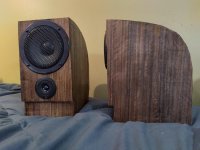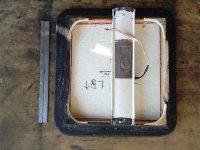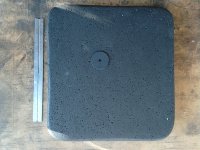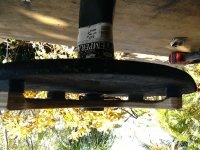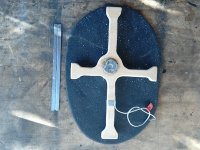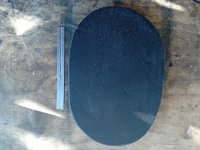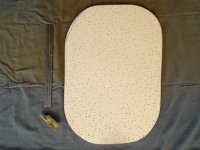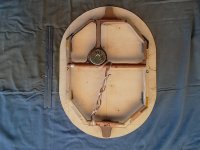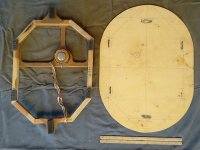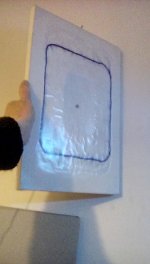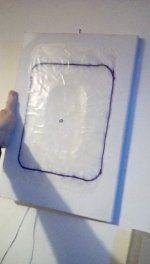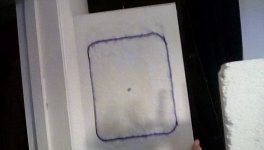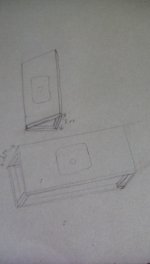Hi, I'm new to this thread, but not to diyAudio. I have ordered the DAEX25FHE-4 exciters, but they have been on backorder for forever. I am to get them in a couple of weeks. Are they too strong for the canvas design? I have read this whole thread, and am super excited! I have a few questions. I am going to do the canvas picture panels. I am wondering about the canvas surface. Should I do the pva mixture first to tighten the canvas, then use acrylic paint thinly to color them? One application I did not see anywhere on this thread (I may have missed it) would be to hang the panels in front of a box. I have built XRK's Nautaloss speakers (see The Nautaloss Ref Monitor on the foamcore thread), which have bass down to 20Hz, as measured using a 20 Hz test tone. How would it be to hang a picture frame DML in front of such a TL, or even mount it directly to the Nautaloss? I can't place any DML out into the room more than a maximum of 1 foot. The Nautaloss is very cheap to build, using only 2 $1 foamcore panels and some polyfill. I laminated veneer to the speakers, the veneer costing more than the whole stereo setup.
Attachments
Last edited:
Here is my latest set build. I started off with 1" EPS and used a 4" wheel grinder to ramp down from the exciter placement "pad" to mostly 1/4" in the larger flat areas and on out to the edge. They are not perfect by any means but pretty damn close to what I was shooting for after a bit of finishing up with hand sanding. Just gotta' be careful not to take off too much with the grinder at first. The spine is pretty much self explanatory.
I made these to replace the smaller square set pictured. Those were my very first experiment with self made TV exciters. They are pretty good but have a harshness to them when played on their own. The small size and nearly square shape and the tiny voice coil on the tiny "exciters" are probably the culprit there. The 2" wooden circle placed directly in front of the exciter did seem to knock back some of that mess, but not much.
The new ones here are a definite improvement. They are 14 x 20 inches freehand. The exciters are also salvage jobs but have a larger diameter voice coil and more panel area to work with. That harshness is gone! Thank goodness. These sound pretty good so far with music but I am getting a few buzz areas from the left one when slowly sweeping with an online tone generator (An absolute must for dialing in these homemade tiny things before the final epoxying into the spine, the slightest bit off is failure). I can put my finger behind the panel and pull to me a bit from behind at the point where i have my foam contacts and the buzzing stops. There is no need to address these problems at the moment because all the glue, epoxy, paint/water/pva coating mixture needs to cure for a few days at least. The paint you see in the pictures is what I mix with water and the yelow PVA wood glue for coating.
I use these for music and surround for movies. I just leave my old Sony amp in auto mode and let it fly between 2.1 and 5.1. I also made a 8 x 14 inch center channel DML the same way and have it over the tv paired in series with a homemade center channel box type I constructed last year that lives under the screen. Let me tell ya', voices are amazing now.
Well, burrito time for me, that's it for a while, hope this helps someone.
I made these to replace the smaller square set pictured. Those were my very first experiment with self made TV exciters. They are pretty good but have a harshness to them when played on their own. The small size and nearly square shape and the tiny voice coil on the tiny "exciters" are probably the culprit there. The 2" wooden circle placed directly in front of the exciter did seem to knock back some of that mess, but not much.
The new ones here are a definite improvement. They are 14 x 20 inches freehand. The exciters are also salvage jobs but have a larger diameter voice coil and more panel area to work with. That harshness is gone! Thank goodness. These sound pretty good so far with music but I am getting a few buzz areas from the left one when slowly sweeping with an online tone generator (An absolute must for dialing in these homemade tiny things before the final epoxying into the spine, the slightest bit off is failure). I can put my finger behind the panel and pull to me a bit from behind at the point where i have my foam contacts and the buzzing stops. There is no need to address these problems at the moment because all the glue, epoxy, paint/water/pva coating mixture needs to cure for a few days at least. The paint you see in the pictures is what I mix with water and the yelow PVA wood glue for coating.
I use these for music and surround for movies. I just leave my old Sony amp in auto mode and let it fly between 2.1 and 5.1. I also made a 8 x 14 inch center channel DML the same way and have it over the tv paired in series with a homemade center channel box type I constructed last year that lives under the screen. Let me tell ya', voices are amazing now.
Well, burrito time for me, that's it for a while, hope this helps someone.
Attachments
I tried to get those photos to display correctly, even went into paint.net and flipped them, but they still got posted upside down. Sorry, did all I could do.
Your problem is EXIF data. Your tablet saves some information to the image container file which defines the orientation.
Toddincabo.
When I opened the pictures on my phone, they turn the correct way up 🤗
Thanks .
Steve.
When I opened the pictures on my phone, they turn the correct way up 🤗
Thanks .
Steve.
Jaxboy.
The exciter you have chosen should work very well although the 4 mounting holes look a bit of a pain? If used?
I'm no expert but pva is water based and will shrink the canvas,this I know.
You could add a dye or maybe water based paint to the pva for colour?
Acrylic is not water based ,so am not sure of the effect of shrinkage?
I used pva to glue the small panel to the canvas so it was an obvious choice to coat the rest of the panel in the same way,with the bonus of shrinkage.
I also purchased 4 very cheap canvas picture frames on ebay,so no work needed to do to the panels,at all !!!
I could hook up the picture panel and see how moving the panel close to the wall effects the sound?
Hopefully with the more powerful exciter you should be able to push the low end down further than the 40hz of my panel?
Steve.
The exciter you have chosen should work very well although the 4 mounting holes look a bit of a pain? If used?
I'm no expert but pva is water based and will shrink the canvas,this I know.
You could add a dye or maybe water based paint to the pva for colour?
Acrylic is not water based ,so am not sure of the effect of shrinkage?
I used pva to glue the small panel to the canvas so it was an obvious choice to coat the rest of the panel in the same way,with the bonus of shrinkage.
I also purchased 4 very cheap canvas picture frames on ebay,so no work needed to do to the panels,at all !!!
I could hook up the picture panel and see how moving the panel close to the wall effects the sound?
Hopefully with the more powerful exciter you should be able to push the low end down further than the 40hz of my panel?
Steve.
But I did notice that in the patent for this type of panel,that they mounted both centrally?
I presume to keep the panel from wobbling at low frequencies,as this is mainly pistonic at these frequencies,supposedly down to 20hz(although mine only went down to 40hz)
Just remembered that when I coated the canvas in pva ,this shrank and tightened the canvas considerably.
Steve.
Interesting points!
Makes me think about adding the PVA treatment into the testing to gain some experience on that and to be able to compare to the gesso primer treatment.
I ll also watch out for some potential wobbling at low frequencies with the panels being attached slightly offset to the canvas while also mounting some in the center.
Thank you for your input, Steve!
Where can I find the patent you were referring to?
I'm almost ready to hang my EPS panels from my ceiling.... but I was wondering, is it worth adding some damping material? I just get a feeling the EPS (2x2 panel) might have some resonances the DSP won't be able to fully control.
Well after trying to fine tune these "oval" EPS speakers (pictured below) I have come to the conclusion that using the "cross shaped frame" design is a no go. The four foam contact points do work but I had to add extra foam top and bottom to get rid of buzzing and it caused the panel to lose volume because of the area size they had to dampen. Lost a ton of flexibility.
A frame all around as pictured below, no more than 1 1/2 inch in from the edge is for sure the way to go as you can apply small pieces of foam directly to any problem area with minimal damping as you use a tone generator to dial in the buzzing. As in said picture (yea I know, its crooked as an Alabama back road) you can see where I had to add extensions top and bottom to tame the buzzing on that piece of 2mm ply that it was attached to, and it worked.
I have some thin MDF that I'll be using to make an entire "back frame" loop to glue to the cross because they are sounding good. I also attached a photo of some ceiling tile I found a crap ton of at the dump the other day. I thought for sure I would find at least some honeycomb cardboard and some nice pieces of EPS but no. I'll be checking these tiles out when I get some real exciters.
A frame all around as pictured below, no more than 1 1/2 inch in from the edge is for sure the way to go as you can apply small pieces of foam directly to any problem area with minimal damping as you use a tone generator to dial in the buzzing. As in said picture (yea I know, its crooked as an Alabama back road) you can see where I had to add extensions top and bottom to tame the buzzing on that piece of 2mm ply that it was attached to, and it worked.
I have some thin MDF that I'll be using to make an entire "back frame" loop to glue to the cross because they are sounding good. I also attached a photo of some ceiling tile I found a crap ton of at the dump the other day. I thought for sure I would find at least some honeycomb cardboard and some nice pieces of EPS but no. I'll be checking these tiles out when I get some real exciters.
Attachments
Last edited:
jaxboy.
i did a very quick test of moving the art panel (30x42cm) close to a wall to see the effect on sound.
as you can hear(I hope) the panel starts to sound tinny and hollow the closer you get to the wall but 1ft sounded ok,I think?
having one edge of the panel hinged to the wall and the other end swung out seamed to work quite well , maybe better than having all of the panel 1ft from the wall?
moving the panel too close to the wall reduced the low end too much hence the tinny sound
i will take some pictures to show what i was doing.
steve
i did a very quick test of moving the art panel (30x42cm) close to a wall to see the effect on sound.
as you can hear(I hope) the panel starts to sound tinny and hollow the closer you get to the wall but 1ft sounded ok,I think?
having one edge of the panel hinged to the wall and the other end swung out seamed to work quite well , maybe better than having all of the panel 1ft from the wall?
moving the panel too close to the wall reduced the low end too much hence the tinny sound
i will take some pictures to show what i was doing.
steve
Attachments
To all.
These pictures give an idea of the positions recorded.
Very basic I know,but it worked.
Smaller panels seem to be able to go closer to the wall with less bad affects than large panels ,my 4inch panel even closer.
I recommend trying different positions and angles for best sound.
Close parallel reflections from the back of the panel and wall are not very nice sounding,so in my mind should be avoided.
But when using small panels ,it's surprising what you can get away with.
Steve
These pictures give an idea of the positions recorded.
Very basic I know,but it worked.
Smaller panels seem to be able to go closer to the wall with less bad affects than large panels ,my 4inch panel even closer.
I recommend trying different positions and angles for best sound.
Close parallel reflections from the back of the panel and wall are not very nice sounding,so in my mind should be avoided.
But when using small panels ,it's surprising what you can get away with.
Steve
Attachments
Just a few thoughts and observations.
I noticed that when I placed the frame on to a small table and held it tight and hard against wood,that LF increased a few db?
I noticed this on my solid wood frame ply panels some years ago.
So might suggest something like my bad drawings in this picture.
A little bit of acoustic wool behind the canvas could be a good idea ?
You could also cover the sides in speaker cloth to hold the wool in.
This would make the panel look more like a normal speaker box?
Obviously the type of wall the frame would be screwed to would make a difference to the sound?
Or screw small door hinges to the naked art frame and wall to adjust to taste,this could also be done to the full square frame also?
Mounting the hinge on the short side of long side?
Rigidly mounting the panel only increases the low end by only a few db ,so don't worry too much about it.
I was holding the panel to the wall with one hand and holding the phone in the other,so I was very close to the panel,so am not able to say how it sounded from a distance?
But my room microphone attached to my deq was showing full frequency output into the room down to 40hz with the panel at least a foot from the wall or hinged outward,but not hard against the wall!
Hope this information is of some use?
Steve
I noticed that when I placed the frame on to a small table and held it tight and hard against wood,that LF increased a few db?
I noticed this on my solid wood frame ply panels some years ago.
So might suggest something like my bad drawings in this picture.
A little bit of acoustic wool behind the canvas could be a good idea ?
You could also cover the sides in speaker cloth to hold the wool in.
This would make the panel look more like a normal speaker box?
Obviously the type of wall the frame would be screwed to would make a difference to the sound?
Or screw small door hinges to the naked art frame and wall to adjust to taste,this could also be done to the full square frame also?
Mounting the hinge on the short side of long side?
Rigidly mounting the panel only increases the low end by only a few db ,so don't worry too much about it.
I was holding the panel to the wall with one hand and holding the phone in the other,so I was very close to the panel,so am not able to say how it sounded from a distance?
But my room microphone attached to my deq was showing full frequency output into the room down to 40hz with the panel at least a foot from the wall or hinged outward,but not hard against the wall!
Hope this information is of some use?
Steve
Attachments
Canvas DML - tuning & size relationships
I am trying to figure how
- tuning the canvas on the one hand and
- changing the relationship of the surface areas of the wooden panel relative to the canvas on the other hand
effect the frequency response of the whole design.
Could someone explain possible causal effects on the frequency response of?
But the stiffer the canvas the more precise, crisp, accurate/less sluggish the bass impulse/response?
So, I ll make the size of the panel big enough for its SPL to remain constant in the low end for long enough, so that the canvas can take over without any noticeable SPL drop in between?
Wouldn't the increase of the panel size relative to the canvas also at the same time increase the stiffness of the canvas (more surface area of the canvas is glued to the stiff(er) wooden panel) and therefore improving the accuracy of the bass impulse?
I am trying to figure how
- tuning the canvas on the one hand and
- changing the relationship of the surface areas of the wooden panel relative to the canvas on the other hand
effect the frequency response of the whole design.
Could someone explain possible causal effects on the frequency response of?
- Tuning the Canvas: The stiffer the Canvas, the...?
- What would be an optimal tuning frequency/stiffness of the Canvas?
But the stiffer the canvas the more precise, crisp, accurate/less sluggish the bass impulse/response?
- Size Relationships: The bigger the size of the wooden panel relative to the canvas, the...?
- What would be an optimal size relationship?
So, I ll make the size of the panel big enough for its SPL to remain constant in the low end for long enough, so that the canvas can take over without any noticeable SPL drop in between?
Wouldn't the increase of the panel size relative to the canvas also at the same time increase the stiffness of the canvas (more surface area of the canvas is glued to the stiff(er) wooden panel) and therefore improving the accuracy of the bass impulse?
Last edited:
From the patent.
The full-range utterance structure of the acoustic according to claim 7, wherein the elastic diaphragm has a tension of 1-50 N and a deformation range of 1-20 mm.
😀
Steve.
The full-range utterance structure of the acoustic according to claim 7, wherein the elastic diaphragm has a tension of 1-50 N and a deformation range of 1-20 mm.
😀
Steve.
The size of the panel I worked out by assuming the exciter coil in the parent drawing was 1inch ?
And worked it out the size from there?
I would think this should put you in the ball park for the optimum size?
Can't remember off hand what that was,it was some time ago.
I wouldn't go too large or too small,for obvious reasons, I hope😀
Steve.
And worked it out the size from there?
I would think this should put you in the ball park for the optimum size?
Can't remember off hand what that was,it was some time ago.
I wouldn't go too large or too small,for obvious reasons, I hope😀
Steve.
art panel size?
just had a quick look at the assumed size of a one inch coil,which comes out to 10inch x15inch.
but if it was a 30mm coil the panel would be in the region of 11inches x 17 inches.
my own art panel with the 1 inch coil is about 11 1/2 inches x 16 1/2 inches.
this size works quite well for me .
the ply used in the patent is about 4 inches x 1 1/2 inches.
mine is 4inches x 6 inches.
what is the ideal size?
the 4x6 inch was just the largest size i could get in bulk on ebay for my small panel testing.
not sure about using a rubber layer between the panel and canvas?
although the pva might be doing the same job?
steve.
just had a quick look at the assumed size of a one inch coil,which comes out to 10inch x15inch.
but if it was a 30mm coil the panel would be in the region of 11inches x 17 inches.
my own art panel with the 1 inch coil is about 11 1/2 inches x 16 1/2 inches.
this size works quite well for me .
the ply used in the patent is about 4 inches x 1 1/2 inches.
mine is 4inches x 6 inches.
what is the ideal size?
the 4x6 inch was just the largest size i could get in bulk on ebay for my small panel testing.
not sure about using a rubber layer between the panel and canvas?
although the pva might be doing the same job?
steve.
Spedge, Thanks for the info. I was planning to hang the canvas in front of doubled thickness and gathered thin drapes. Should I also put a panel of 1/2"melamine sponge (like XRK uses for lining his speaker boxes) into the drapes for added dampening? The canvas will be 1 1/2' from the window, with the drapes being 1/2' from the window. What do you think about placing the canvas in front of a box, like the stuffed fibonacci coil TL Nautaloss speaker I showed in my post? IMO that would make it a BMR speaker, am I right? As an additional brain fart, how would coating the melamine sponge with the water/glue work as a DML panel? i would imagine it would be too soft, correct?
Last edited:
jaxboy.
You'll have to test the sound when the panel is in position
A foot and a half of space and and drapes behind the panel should be fine.
If all goes well you should get a strong in room low end response without the need for a box.
Although ,if you listen to very loud rock or electronic music a sub would probably be needed😀
The beauty of a dml panel is the omnidirectional open natural sound,placing the panel in a box would turn it into an ordinary speaker and you'd loose the natural rear sound wave.
I have a large window with only roller blinds behind my panels admittedly three feet away.
Come to think of it ,I could make a recording with the art panel a foot and a half in front of the window with and without the roller blinds?
Could be interesting?
Why not.
Steve.
Ps.
I wouldn't have thought pva and foam would work well as a panel?
You'll have to test the sound when the panel is in position
A foot and a half of space and and drapes behind the panel should be fine.
If all goes well you should get a strong in room low end response without the need for a box.
Although ,if you listen to very loud rock or electronic music a sub would probably be needed😀
The beauty of a dml panel is the omnidirectional open natural sound,placing the panel in a box would turn it into an ordinary speaker and you'd loose the natural rear sound wave.
I have a large window with only roller blinds behind my panels admittedly three feet away.
Come to think of it ,I could make a recording with the art panel a foot and a half in front of the window with and without the roller blinds?
Could be interesting?
Why not.
Steve.
Ps.
I wouldn't have thought pva and foam would work well as a panel?
- Home
- Loudspeakers
- Full Range
- A Study of DMLs as a Full Range Speaker
